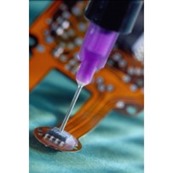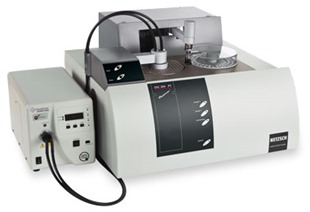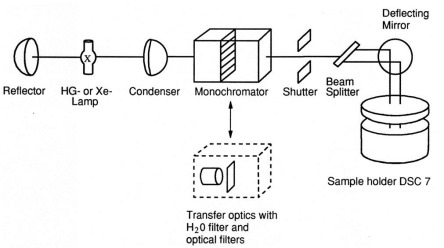 In the last few posts, the utility of using a rheometer with a UV exposure accessory was discussed. The UV rheometer method is very useful for measuring the physical changes during UV exposure, such as how the dynamic loss and storage moduli changed during UV curing. Monitoring the viscosity as a function of time for various UV exposure doses has important practical uses as was seen in the measurement of the time to gel which defines the process window during curing. Differential Scanning Calorimetry (DSC) is an important tool in thermoset characterization. In the same light, several DSC equipment manufacturers have developed accessories to enable UV exposure and subsequent in-situ cure monitoring.
In the last few posts, the utility of using a rheometer with a UV exposure accessory was discussed. The UV rheometer method is very useful for measuring the physical changes during UV exposure, such as how the dynamic loss and storage moduli changed during UV curing. Monitoring the viscosity as a function of time for various UV exposure doses has important practical uses as was seen in the measurement of the time to gel which defines the process window during curing. Differential Scanning Calorimetry (DSC) is an important tool in thermoset characterization. In the same light, several DSC equipment manufacturers have developed accessories to enable UV exposure and subsequent in-situ cure monitoring.
- Perkin Elmer
- TA Instruments
- Mettler Toledo
- Netzsch Instruments
As observed in the above photos, standard DSC’s are modified by adding a controlled UV light source with a fiber optic cable capable of providing sample exposure in the DSC pan.
The following figure shows a schematic of a Perkin Elmer DSC7 and the DPA7 accessory.
Note that a beam splitter is used to expose both the sample and reference in the DSC cell. Similar to standard DSC measurements, a reference pan (without a sample) is placed on one side of the DSC cell as seen in the figure below. The reference pan is used to establish the instrument baseline.
Image courtesy of Metter Toledo
Typical Applications evaluated using UV DSC
- UV coatings for low VOC applications
- Dental composite materials
- Photoresists (and photo-imageable polymers) used in electronic applications
- UV cured adhesives
The advantages of using UV DSC:
- Provides an efficient method to determine the curing kinetics for UV curing systems
- Investigate the role of UV exposure dose and UV intensity on the cure reaction
- Compare the efficiency of various UV photoinitiators
- Evaluate the degree of cure and glass transition temperature after UV exposure (important in process optimization)
In upcoming posts, examples of using UV DSC to investigate photo curing will be presented.





Leave a Reply